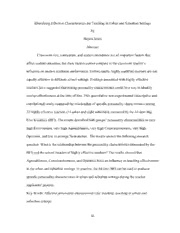
ERIC ED574043: Identifying Characteristics for Effective Teaching in Urban and Suburban Settings. PDF
Preview ERIC ED574043: Identifying Characteristics for Effective Teaching in Urban and Suburban Settings.
IDENTIFYING EFFECTIVE CHARACTERISTICS FOR TEACHING IN URBAN AND SUBURBAN SETTINGS A dissertation submitted by SHAWN CECIL JONES January, 2017 to School of Organizational Leadership UNIVERSITY OF THE ROCKIES Upon the recommendation of the Faculty and the approval of the Board of Trustees, this dissertation is hereby accepted in partial fulfillment of the requirements for the degree of DOCTOR OF PSYCHOLOGY Peggy Sundstrom, PhD Committee Chair Committee Members: David Bearden, PhD Alecia Richardson, PhD Copyright by Shawn Cecil Jones 2017 ii Identifying Effective Characteristics for Teaching in Urban and Suburban Settings by Shawn Jones Abstract Classroom size, curriculum, and student attendance are all important factors that affect student outcomes, but these factors cannot compare to the classroom teacher’s influence on student academic performance. Unfortunately, highly qualified teachers are not equally effective in different school settings. Findings associated with highly effective teachers have suggested that testing personality characteristics could be a way to identify teacher effectiveness at the time of hire. This quantitative non-experimental (descriptive and correlational) study examined the relationship of specific personality characteristics among 22 highly effective teachers (14 urban and eight suburban), measured by the 44-item Big Five Inventory (BFI). The results described both groups’ personality characteristics as very high Extroversion, very high Agreeableness, very high Conscientiousness, very high Openness, and low to average Neuroticism. The results answer the following research question: What is the relationship between the personality characteristics (measured by the BFI) and the school location of highly effective teachers? The results showed that Agreeableness, Conscientiousness, and Openness have an influence on teaching effectiveness in the urban and suburban settings. In practice, the 44-item BFI can be used to evaluate specific personality characteristics in urban and suburban settings during the teacher applicants’ process. Key Words: Effective personality characteristics for teaching, teaching in urban and suburban settings. iii Table of Content CHAPTER1: INTRODUCTION .........................................................................................1 General Statement ....................................................................................................2 Problem Statement ...................................................................................................4 Purpose of Study ......................................................................................................8 Importance of Study ...............................................................................................11 Theoretical Framework ..........................................................................................13 Research Questions and Hypotheses .....................................................................17 RQ1: Extroversion .....................................................................................18 RQ2: Agreeableness...................................................................................19 RQ3: Conscientiousness ...........................................................................19 RQ4: Openness .........................................................................................19 RQ5: Neuroticism ......................................................................................19 Overview of Research Design ...............................................................................20 Definition of Terms................................................................................................28 Assumptions ...........................................................................................................29 Limitations .................................................................................................30 Delimitations ..............................................................................................31 Summary ................................................................................................................32 CHAPTER II: LITERATURE REVIEW ..........................................................................34 Search Strategy ......................................................................................................35 Human Capital Management and Evaluation ........................................................36 Teacher Evaluation Challenges..................................................................40 Teacher Evaluation Reform .......................................................................41 Hiring Effective Teachers ..........................................................................43 iv Teaching Success in Urban Settings ..........................................................45 Teaching Success in the Suburban Setting ................................................51 The Validity of the 44-item Self-report Big Five Inventory ..................................55 Myers Briggs Type Indicator .....................................................................60 The Big Five Inventory Versus the Myers-Briggs Type Indicator ........................61 Big Five Inventory ....................................................................................61 Fundamental Interpersonal Relationship Orientation ............................................63 The Big Five Inventory Versus the Fundamental Interpersonal Relations Orientation .................................................................................................64 Selecting an Assessment Instrument ..........................................................65 The Utility of the Big Five Inventory ....................................................................66 Summary ................................................................................................................66 CHAPTER III: METHOD .................................................................................................70 Methodology ..........................................................................................................70 Research Questions and Hypotheses .....................................................................72 Hypothesis 1: Extroversion .......................................................................74 Hypothesis 2: Agreeableness .....................................................................74 Hypothesis 3: Conscientiousness ..............................................................75 Hypothesis 4: Openness ............................................................................75 Hypothesis 5: Neuroticism .........................................................................76 Population and Sample ..........................................................................................76 Population ..............................................................................................................76 Sample ...................................................................................................................80 Ethical Concerns ....................................................................................................82 Instrument ..............................................................................................................84 v Data Collection ......................................................................................................86 Data Analysis .........................................................................................................88 Descriptive Statistics ..................................................................................89 Correlational Statistics ...............................................................................90 Validity ..................................................................................................................91 Summary ................................................................................................................93 CHAPTER IV: RESULTS .................................................................................................94 Sample....................................................................................................................96 Data Collection ......................................................................................................99 Data Analysis and Results ...................................................................................100 Descriptive Statistics ................................................................................101 Correlational Statistics .............................................................................104 Conclusion ...........................................................................................................107 CHAPTER V: DISCUSSION ..........................................................................................110 Introduction ..........................................................................................................110 Interpretation of Findings ....................................................................................112 Overview of Major Findings ....................................................................114 Interpretation of Major Findings ..............................................................116 Correlational Statistics .............................................................................119 Limitation of Study ..............................................................................................126 Limited Access to the Target Population .............................................................126 Limited Time and Financial Resources ..............................................................128 Implication for Theory and Research ..................................................................129 Implication for Practice........................................................................................131 Recommendation for Future Research .................................................................133 vi Conclusion ...........................................................................................................134 REFERENCES ................................................................................................................137 vii LIST OF TABLES Table 1: Myers Briggs Type Indicator vs Big Five Inventory ..........................................15 Table 2: Overview of Research Design ............................................................................23 Table 3: Big Five Inventory Factors .................................................................................57 Table 4: Academic Performance Index .............................................................................77 Table 5: Reliability and convergent validity coefficients .................................................85 Table 6: Urban Participant Descriptive Statistics ...........................................................102 Table 7: Suburban Participant Descriptive Statistics ......................................................103 Table 8: Spearman’s Rank Correlation Coefficient of Personality Characteristics ........105 viii LIST OF FIGURES Figure 1: Eighth Grade Science Scores by Race and Income ...........................................53 ix LIST OF APPENDICES Appendix A: 44-Item Big Five Inventory ........................................................................150 Appendix B: Power Sample Calculation .........................................................................152 Appendix C: Informed Consent Form ............................................................................153 Appendix D: Scoring ......................................................................................................155 Appendix E: Sample Size ................................................................................................157 Appendix F: Comparison Sample: Means and Standard Deviations for BFI ..................158 Appendix G: BFI Approval .............................................................................................160 x
